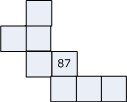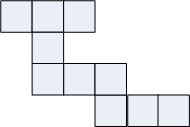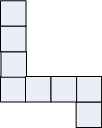Using a Hundreds Chart: 1.5
Supporting materials
- Related Progression Points
- Developmental Overview of Numeration: Base Ten and Place Value Properties (PDF - 28Kb)
Indicator of Progress
Students can use the hundreds chart to find relationships between numbers. For example, 42 is the number 10 more than 32, and so 42 is directly below 32 on the hundreds chart. Likewise the number 33 is next to 32, and it is 1 more than 32.
Some students do not see the base ten patterns underlying the hundreds chart and attempt to count by ones. For example, when asked the number that is ten more than 23 they touch or say each number until they get to 33.
Research has shown that persisting with counting by ones to add and subtract is a characteristic of students who do not make adequate progress in mathematics.
Illustration 1: Visualising the hundreds chart
Using the pattern of the hundreds chart (without necessarily looking at the chart), students can say 10 more (or less) than a number without calculating or counting on. If they don’t see the pattern, then they will probably count by ones.
Illustration 2: Multi-step problems
Some students do not see the base ten patterns in the hundreds chart and attempt to count by ones to solve these problems. For example, when asked the number that is 10 more than 23 they touch or say each number until they get to 33. Once students appreciate the patterns they can then solve multi-step problems such as 32 + 20, 32 -11, 32 -9 firstly by directly referring to the chart and later by visualising it.
Illustration 3

Examples of the types of tasks that would be illustrative of mental calculation concepts using a hundreds chart, aligned from the Mathematics Online Interview:
- Question 3 - Give numbers before and after
- Question 4 - Counting by 10s, 5s, 2s starting from 0
- Question 8 - Reading Numerals – 2 digit numbers
- Question 9 (a) (b) - Use calculator to record and say numbers – 2 digits
- Question 10 (a) (b) - Order 1 and 2 digit number sets of cards
- Question 11 - Make 36 using bundles of 10 sticks and single sticks
- Question 12 - Find the missing number on a 20 digit chart
Teaching Strategies
The main focus is to assist students to visualise the patterns in the hundreds chart, which will improve their ability to calculate mentally. While initially students may need to see a chart, ultimately they will visualise the patterns and solve problems without reference to the chart.
Activity 1: Guess my number focuses attention on the positions of digits on the chart.
Activity 2: Number neighbours looks at numbers above and below, right and left, of a chosen number.
Activity 3: Missing numbers and Activity 4: Challenges lead towards visualising the chart and mental strategies.
Activity 1: Guess my number
Pose this task “I am thinking of a two digit number. One of my digits is 6. What number might I be thinking of?”
There are many possible numbers. Encourage the students to find multiple answers. Discuss how some students think of numbers with a 6 in the ones place, and others might find numbers with a 6 in the tens place.

Activity 2: Number neighbours
One aspect of place value is visualising the patterns that connect a particular number to its neighbours. A range of activities can involve hundreds charts. There are several different charts below. Note that the first chart has been extended to include the numbers up to 120, and that the second chart is a 0-99 chart. It is important that students are exposed to different formats of the hundreds chart in order to highlight different patterns. A portion of the next chart (100-199) is also provided. The pattern then extends, so that all numbers with 4 in the hundreds place are in the same chart (400-499). Hundreds charts are available as a downloadable Pdf document below.
- Hundreds Chart (PDF - 14Kb) - Pdf document with three different versions of a Hundreds Chart (1-120, 1-100, 0-99)
You could cut up any of these charts along some lines to make a jigsaw piece. Ask students to reassemble the chart from the pieces and discuss strategies.
|
1 |
2 |
3 |
4 |
5 |
6 |
7 |
8 |
9 |
10 |
|
11 |
12 |
13 |
14 |
15 |
16 |
17 |
18 |
19 |
20 |
|
21 |
22 |
23 |
24 |
25 |
26 |
27 |
28 |
29 |
30 |
|
31 |
32 |
33 |
34 |
35 |
36 |
37 |
38 |
39 |
40 |
|
41 |
42 |
43 |
44 |
45 |
46 |
47 |
48 |
49 |
50 |
|
51 |
52 |
53 |
54 |
55 |
56 |
57 |
58 |
59 |
60 |
|
61 |
62 |
63 |
64 |
65 |
66 |
67 |
68 |
69 |
70 |
|
71 |
72 |
73 |
74 |
75 |
76 |
77 |
78 |
79 |
80 |
|
81 |
82 |
83 |
84 |
85 |
86 |
87 |
88 |
89 |
90 |
|
91 |
92 |
93 |
94 |
95 |
96 |
97 |
98 |
99 |
100 |
|
101 |
102 |
103 |
104 |
105 |
106 |
107 |
108 |
109 |
110 |
|
111 |
112 |
113 |
114 |
115 |
116 |
117 |
118 |
119 |
120 |
|
0 |
1 |
2 |
3 |
4 |
5 |
6 |
7 |
8 |
9 |
|
10 |
11 |
12 |
13 |
14 |
15 |
16 |
17 |
18 |
19 |
|
20 |
21 |
22 |
23 |
24 |
25 |
26 |
27 |
28 |
29 |
|
30 |
31 |
32 |
33 |
34 |
35 |
36 |
37 |
38 |
39 |
|
40 |
41 |
42 |
43 |
44 |
45 |
46 |
47 |
48 |
49 |
|
50 |
51 |
52 |
53 |
54 |
55 |
56 |
57 |
58 |
59 |
|
60 |
61 |
62 |
63 |
64 |
65 |
66 |
67 |
68 |
69 |
|
70 |
71 |
72 |
73 |
74 |
75 |
76 |
77 |
78 |
79 |
|
80 |
81 |
82 |
83 |
84 |
85 |
86 |
87 |
88 |
89 |
|
90 |
91 |
92 |
93 |
94 |
95 |
96 |
97 |
98 |
99 |
|
100 |
101 |
102 |
103 |
104 |
105 |
106 |
107 |
108 |
109 |
|
110 |
111 |
112 |
113 |
114 |
115 |
116 |
117 |
118 |
119 |
|
120 |
121 |
122 |
123 |
124 |
125 |
126 |
127 |
128 |
129 |
Activity 3: Missing numbers
Once students can put a complete chart together, prepare a chart with some numbers missing. Cut the chart into 'jigsaw' pieces. You could use jigsaw pieces with only one number showing for the students to complete the missing numbers. For example what numbers are missing in the boxes shown? Always, students should describe how they obtain answers in terms of adding or subtracting 10 (moving vertically) or 1 (moving horizontally).
 |
 |
Activity 4: Challenges
Once students are confident completing the chart with one given number on each jigsaw piece you can ask more open-ended questions.
For example:
The number 43 is covered by pieces like these shown below. What other numbers might be covered?
 |
 |
Other challenge tasks include:
- Draw the smallest jigsaw piece that contains a number and the number 11 more than it.
- Draw the smallest jigsaw piece that contains a number and the number that is 20 more than it.
- Draw the smallest jigsaw piece that contains a number and the number 9 less than it.
